By Andrea Naccarato/DWR
If you wanted to see butterflies on a warm, sunny day, where would you go? For many, a garden full of flowers may be the first place on the list. Flowers with nectar can be attractive stopping points for passing butterflies, but the butterflies might not stick around the garden for long. Why might this be? Some habitat features important to butterflies might be missing from the flower garden.
A garden found in a park or residential community may have a variety of colorful flowers that encourage butterflies to visit. But, if a female butterfly is seeking host plants for her offspring (caterpillars), she will continue searching until she finds the right plants. The gardens that keep butterflies around have specific features, in addition to their nectar plants, that are similar to butterflies’ natural habitats.
Natural habitats for butterflies include a variety of environments like prairies, forests, and wetland edges that include many types of plants, from trees and shrubs to wildflowers and grasses. Good butterfly habitats provide:
- Food
- Host plants for caterpillars
- Nectar plants for adult butterflies
- Water (in moist soil)
- Shelter
- Basking sites
- Egg-laying sites/host plants
It is the complete habitat, whether natural or created, that provides all the things a butterfly needs to survive throughout its life cycle and to create the next generation.
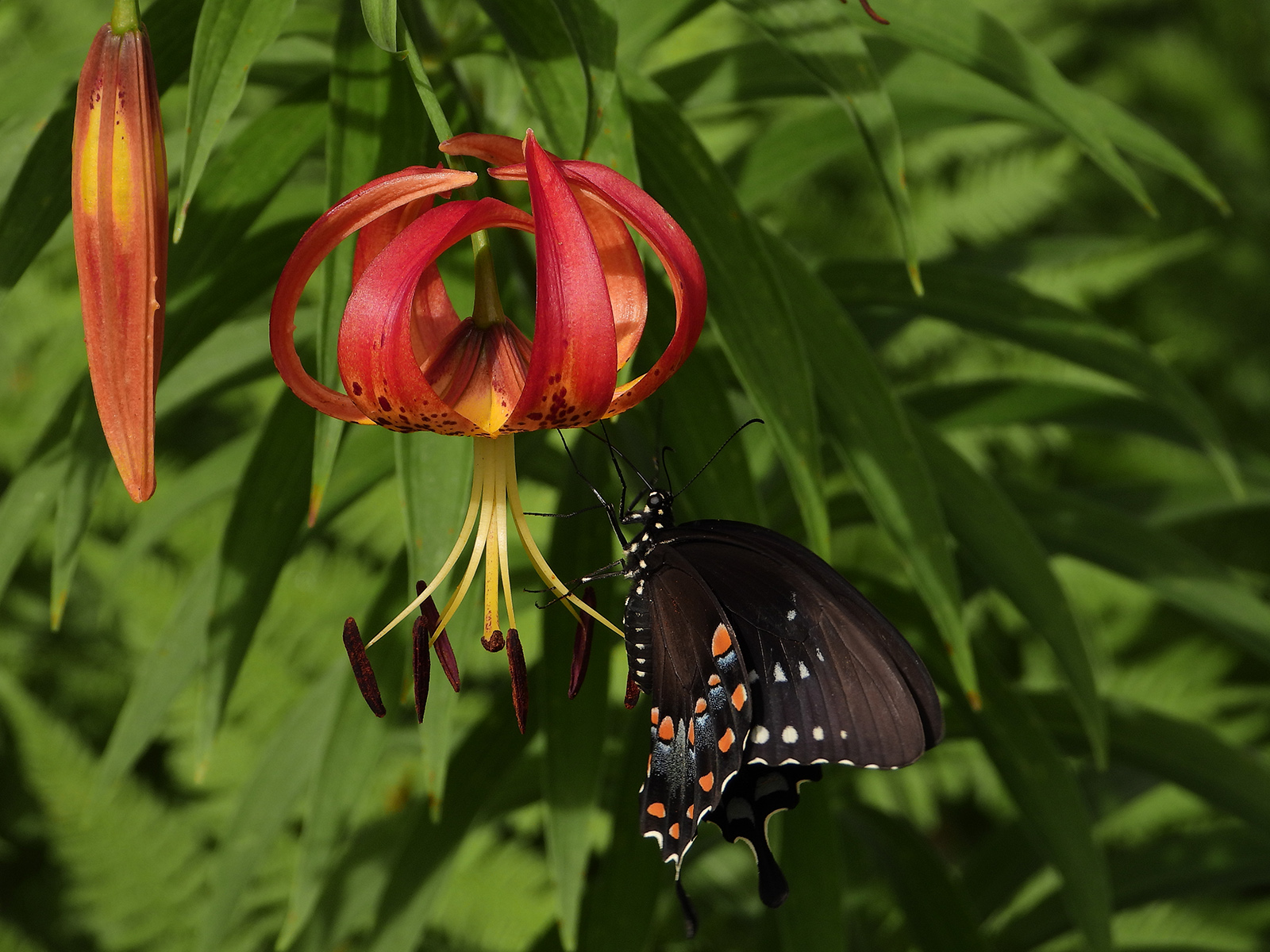
It will take more than nectar from this lily flower to support a new generation of spicebush swallowtails. Additional habitat features, such as food for its caterpillar offspring, are also essential for butterfly survival and reproduction. Photo by Darl Fletcher
What do butterflies need to survive and reproduce?
As described above, butterfly populations are not sustained by flowers alone. Even though the adult butterflies may be the most noticeable life stage as they float among the flowers, there are habitat requirements needed for the egg, caterpillar, and chrysalis stages, too. (See An Introduction to Virginia’s Butterflies for a review of the butterfly life cycle.) The following types of plants and other features are necessary components of butterfly habitats:
Host plants
Host plants fulfill two extremely important roles in the butterfly’s life cycle. These are the plants that serve as egg-laying sites and food for the caterpillars. As caterpillars, many kinds of butterflies are specialized to eat only certain types of plants. Female butterflies taste the plant with special receptors on their feet to confirm they have found the correct host plant before laying their eggs. When the caterpillars hatch, they generally consume new leaves, but some species may also eat flower buds or other soft plant parts.
The monarch’s relationship with milkweed is perhaps the most famous butterfly-host plant pairing. Because their caterpillars are picky eaters (relying on plants in the milkweed family only), monarchs are considered host plant specialists. Besides getting a satisfying meal, monarch caterpillars also consume plant chemicals within the milkweed that make them distasteful to predators, thus improving their odds of survival. Two other examples of Virginia butterflies that are linked with specific host plants include the zebra swallowtail (host plant: pawpaw, Asimina sp.) and great spangled fritillary (host plant: violets, Viola sp.).
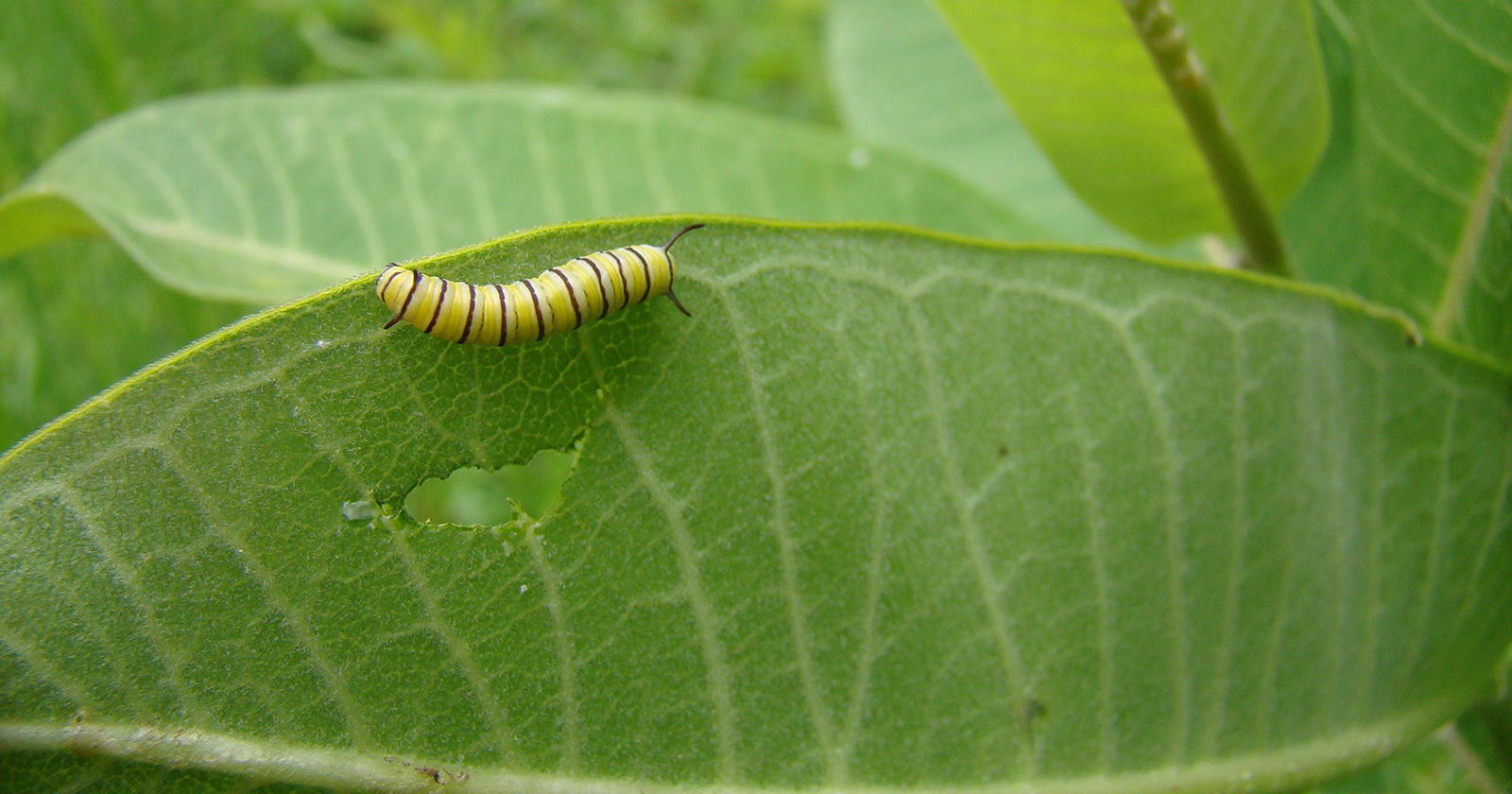
Monarch caterpillars must eat leaves from their milkweed host plants to successfully develop into adult butterflies. Photo by Andrea Naccarato/DWR
Other butterflies are categorized as host plant generalists because they lay their eggs on a wider variety of plants, sometimes even across multiple plant families. Some generalist species in Virginia include the Eastern tiger swallowtail (our state insect), painted lady, and red-spotted purple. Butterflies that are host plant generalists may be more commonly seen across a wider variety of habitats than the specialists, depending on the habitat specificity of the specialist’s host plant.
Refer to local butterfly field guides and other resources listed below to learn host plants for individual butterfly species.
Nectar plants
Adult butterflies seek out flowers that are full of sugary nectar. This energy-rich liquid provides calories needed to power these flying creatures. Butterflies are less picky about choosing their nectar plants (as compared to their host plants). Plants that produce tight clusters of flowers or flower heads composed of florets are popular with butterflies, as the flower cluster serves as a stable platform that allows the butterfly to sip nectar from a series of flowers while resting. Some examples of Virginia native nectar plants with these types of flower clusters include asters (like joe pye weed), buttonbush, elderberry, some milkweeds, and many more.

Milkweeds are nectar plants, too! These pearl crescents can drink nectar from multiple flowers on this butterfly milkweed (Asclepias tuberosa) before using energy to fly to another nectar plant. Photo by Andrea Naccarato/DWR
Open patches of moist soil
It’s easy to overlook the importance of little patches of bare ground in our landscapes. These seemingly “blank” spaces may become gathering places for butterflies of various species, especially after drought-quenching rain. Once the soil becomes moist, a butterfly can use its tongue (or “proboscis”) to absorb mineral-rich fluids and supplement its sugar-rich nectar diet. This behavior is referred to as “puddling” and may also happen around fresh puddles along dirt roads or trails. Males especially partake in puddling because some of the nutrients they imbibe are passed to females during mating and may increase their reproductive success.
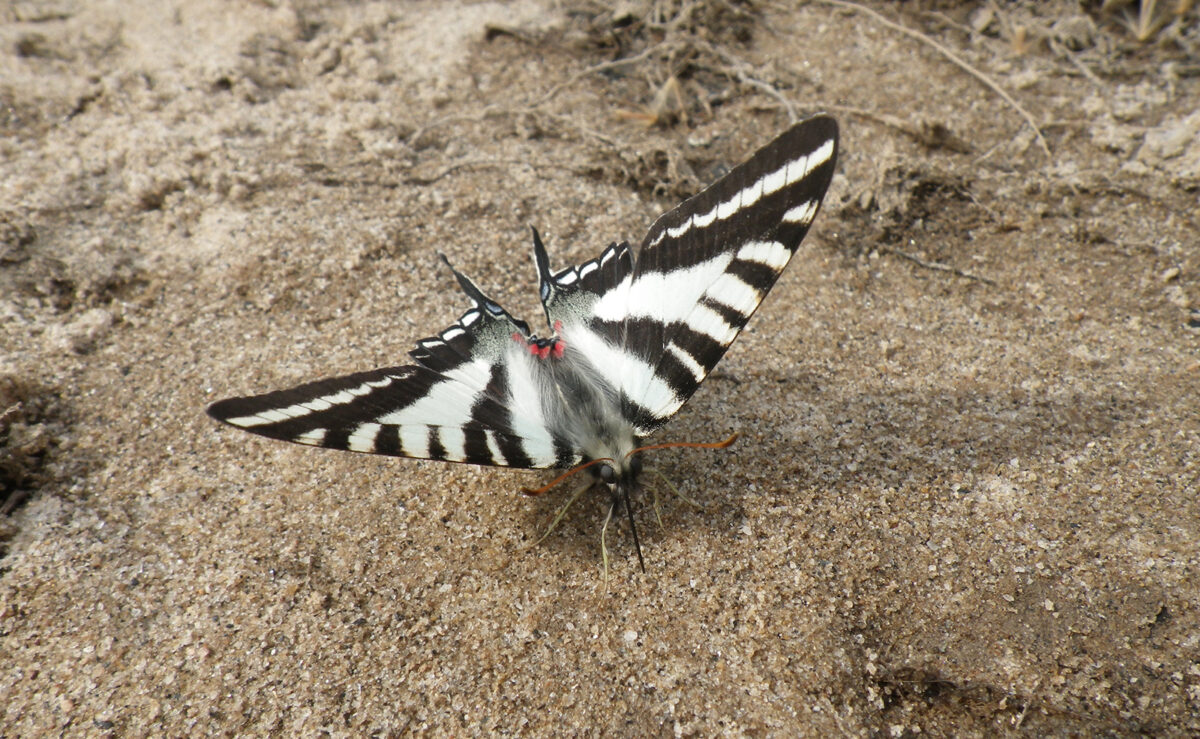
This zebra swallowtail is using its proboscis to absorb mineral-rich fluids from a moist patch of soil. Photo by Callie Evans
Basking sites
Early in the flight season or on cool mornings, our first glimpse of a butterfly may be while it is basking rather than flying. A basking butterfly is typically perched with its wings open in a location that receives direct sunlight. Good basking sites include a broad leaf near the top or edge of a plant (not shaded by other leaves) or dark-colored rock or other substrate (as darker colors absorb more heat). Sometimes, basking butterflies are easy to miss because they can remain motionless for quite a while, waiting for their bodies to absorb enough heat from the sun before they can start visiting their host plants and nectar plants.
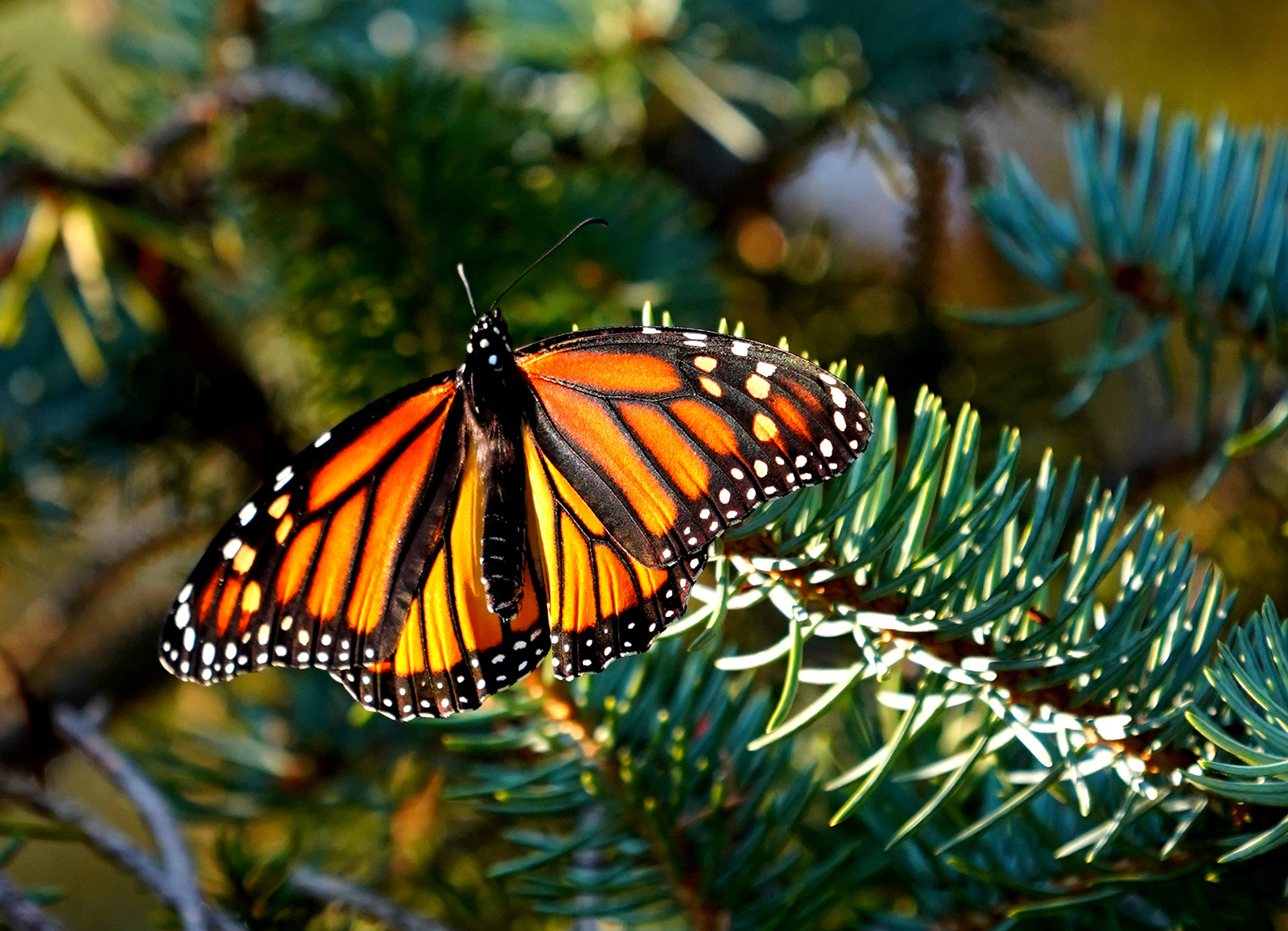
A branch tip in a shaft of sunlight can be a perfect basking site for butterflies, like this monarch. Photo by Vicki Wishon
Shelter
Places to seek shelter are also supremely important to the survival of butterflies across the seasons and from day to day. Adult butterflies need safe spots to spend the night or shield against bad weather. Winter is an especially challenging time for cold-blooded (or “ectothermic”) insects like butterflies. Depending on the species, butterflies may overwinter as eggs, caterpillars, chrysalises, or adults.
Piles of branches or leaf litter on the ground are suitable shelter locations for butterflies in various life stages. Unhatched eggs might ride out the winter at the bases of dormant host plants or in grasses nearby. Some species wait for warm temperatures as a chrysalis attached to twigs or other sturdy structures. Adult butterflies might tuck themselves into tree cavities or between layers of loose bark.
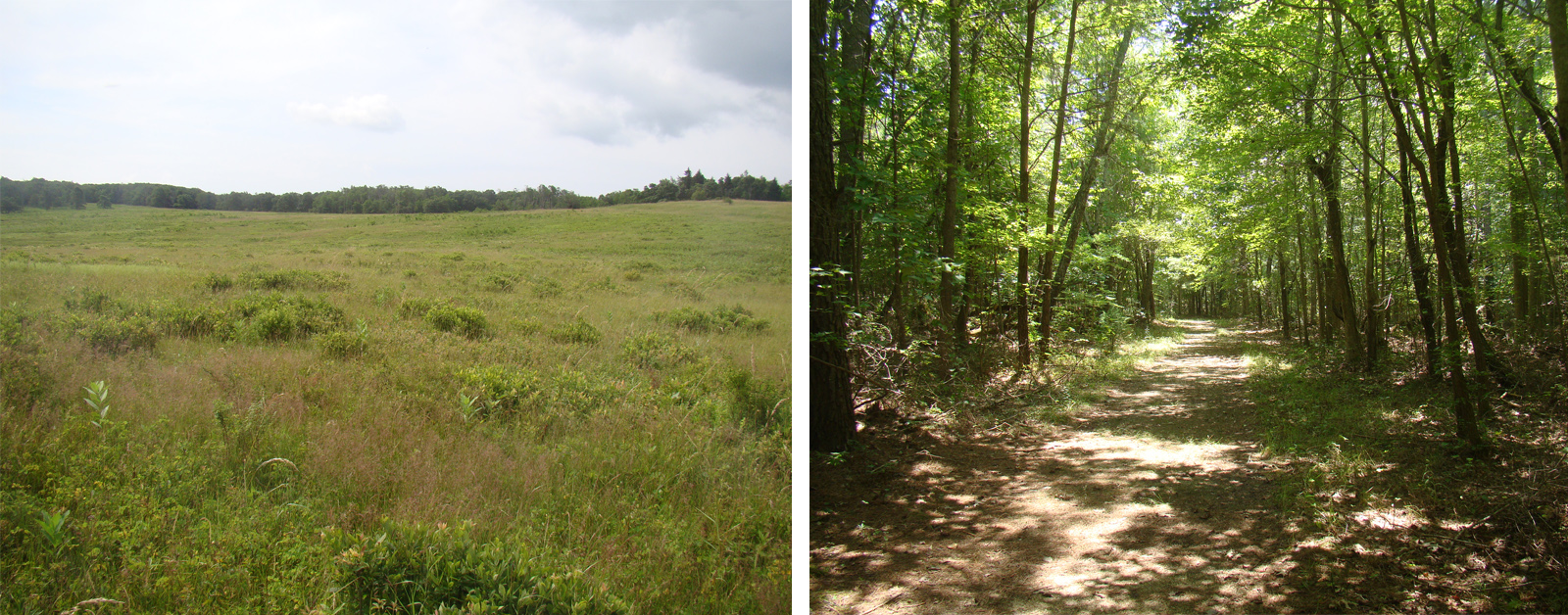
These two very different landscapes are both butterfly habitats. Can you identify good places for butterflies to take shelter in either photo? Photos by Andrea Naccarato/DWR
You can create, maintain, or improve butterfly habitats at home
Offering appropriate habitat for wildlife, including butterflies, in our outdoor spaces can help provide the resources those wildlife species need. The Virginia Department of Wildlife Resources (DWR) promotes the concept of “Habitat at Home” as a way to connect residents with nature that is so close, it may be a matter of taking two steps outside your home.
“Our society sometimes operates on the idea that wildlife and their habitats are something separate from our everyday existence,” says Stephen Living, DWR’s habitat education coordinator. “Recognizing that our home spaces are part of the wider natural world can increase our enjoyment and connection to nature and offer the chance to do something positive for wildlife.”
Your home landscape may have more potential butterfly habitat than you think!
Pre-existing butterfly habitats
Anytime you see a butterfly around your home, it may be an indication that you already have butterfly habitat. When a butterfly arrives, pay attention to the areas that it visits and which plants or other features it interacts with. Roadsides, fence edges, and other overlooked corners of the property that might appear “weedy” to us may contain host plants and nectar plants for butterflies.
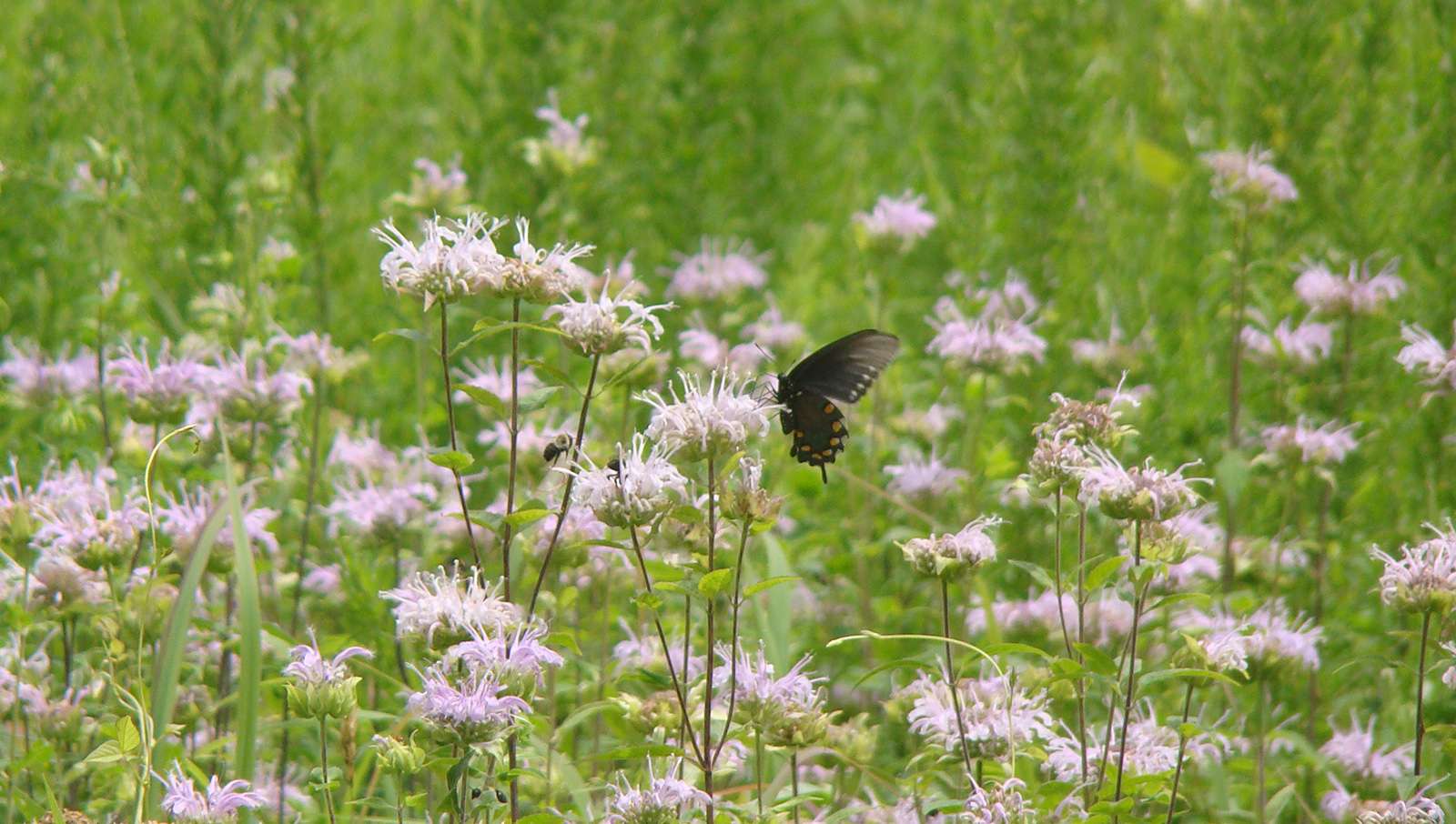
A corner of your landscape that appears “overgrown” may be a pollinator paradise, filled with a variety of nectar plants and host plants for butterflies. Photo by Andrea Naccarato/DWR
Once you notice where butterflies are spending their time, think about things you can do to keep them around. Mowing less often, choosing not to mow patches of blooming wildflowers, leaving dormant vegetation on the landscape, and keeping fallen leaves on the ground are all easy ways to preserve butterfly habitat.
Butterfly gardens
In contrast to pre-existing habitats, butterfly gardens are often designed with plants that were specifically chosen by the gardener to attract and sustain butterflies. Appropriate sites are selected that receive plenty of sun, especially over the summer. Everything the butterfly needs for its entire life cycle should be present, meaning the garden itself functions as a habitat.
Host plants should be there as egg-laying sites and for caterpillars to eat. Plants that show signs of caterpillar munching are a measure of success in a butterfly garden!

Any successful butterfly garden is home to caterpillars eating their host plants. Depending on the butterfly species, the caterpillars may eat leaves, flower buds, or even developing fruits or seedpods, as seen here. Photo by Leo Meire
A variety of nectar plants with flowers in different colors and shapes and staggered bloom times will serve a wider range of species. Even a few plants offered in containers on an open-air balcony or patio can provide much-needed resources for butterflies.
If you are creating or tending gardens around your home property, try to leave some patches of soil or gravel where butterflies can gather to absorb salts and minerals. Remember to provide piles of leaves or twigs for butterflies in all life stages to take shelter for the winter.
What should be missing (or extremely limited) in a butterfly garden? Pesticides. Unfortunately, these chemicals may have negative effects on non-target insects, including butterflies. Strive to include a good diversity of plants, which is more likely to support a good diversity of critters (plant-eaters and insect-eaters) that will balance each other’s populations.
Going native
Make sure the majority of the plants you select for your butterfly garden are native species. According to Living, “Our wildlife has deep and ancient connections to the native plants that they’ve evolved with.” He explained that gardens composed of non-native plants that are only sources of nectar won’t be enough to support the next generation of butterflies.
“That’s why we recommend skipping non-native (and potentially invasive) plants like butterfly bush [Buddleja sp.],” Living continued. “It may attract lots of nectaring butterflies—but it doesn’t grow any caterpillars.”
Instead, choose native milkweeds, golden alexanders, and asters that provide nectar for adult butterflies and herbaceous food for certain caterpillars.

The native pollinator gardens outside of DWR Headquarters in Henrico were planted with a wide variety of nectar plants and host plants for butterflies. As spring warms to summer, different kinds of plants emerge and bloom flowers in a rainbow of colors, providing for many butterflies and other pollinators. Photo by Andrea Naccarato/DWR
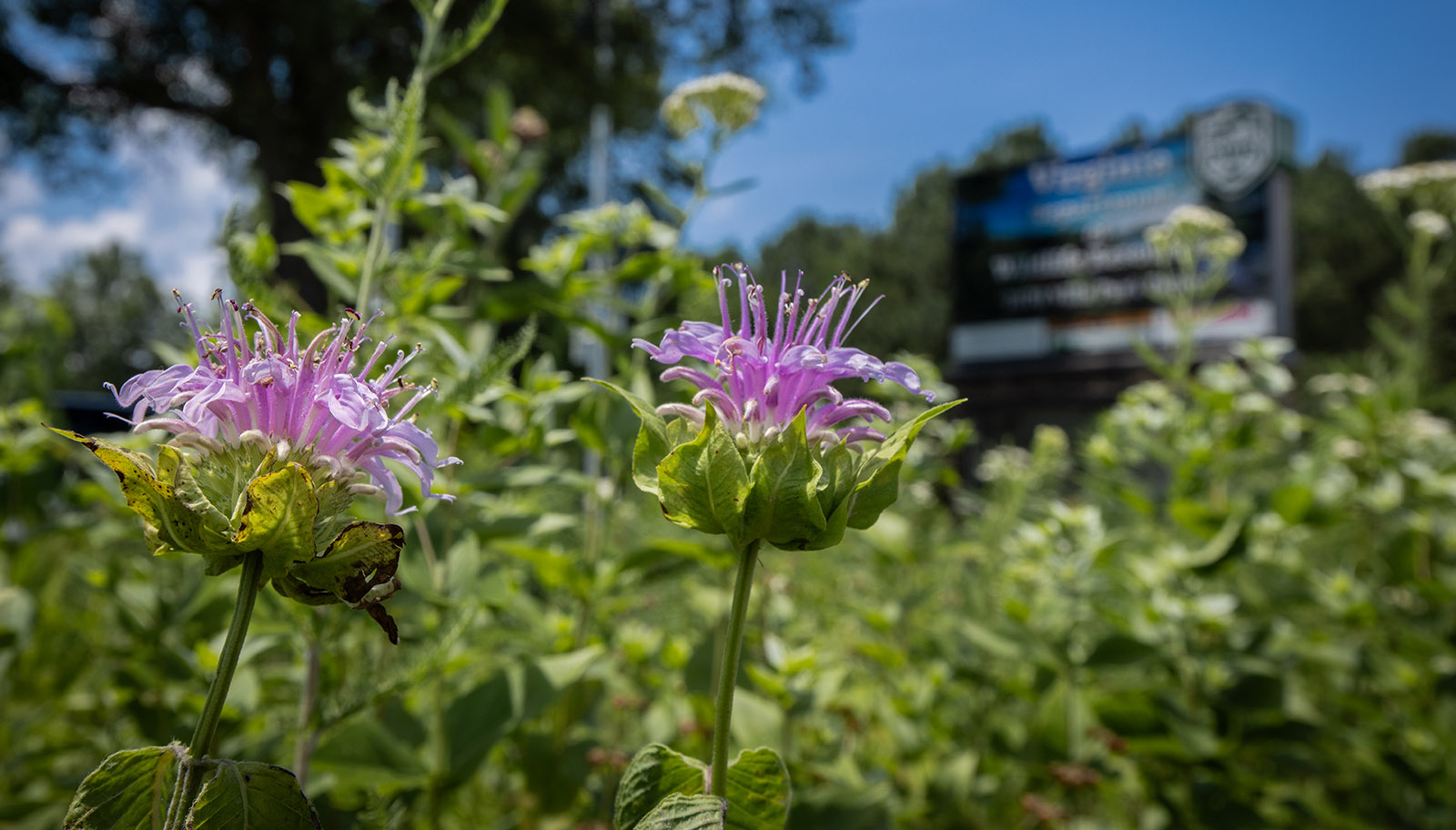
Photo by Meghan Marchetti/DWR
Plus, Living emphasized, “Don’t forget the trees! These are a critical part of Habitat at Home. A native tree like our black cherry (Prunus serotina) provides nectar and fruit and is a host plant for many different insects, including Virginia’s state insect, the Eastern tiger swallowtail!”
Although gardeners interested in creating native butterfly gardens may feel a little overwhelmed at the beginning, Living reminds us: “Small steps matter—replacing one invasive plant with a valuable native is a win that you can build on to grow a Habitat at Home.”
You can read an introduction to Virginia’s butterflies and learn about butterfly counts in the two previous articles in this series. Comprehensive lists of native plants for butterflies and suggestions for designing butterfly habitats can be found in the resources section below.
______________________________________________________________________________
Andrea Naccarato is the DWR Outreach Production Assistant. During her first summer living in Virginia, she participated in eight butterfly counts that ranged from the Coastal Plain to the Blue Ridge.
Resources
Books:
Attracting Native Pollinators: Protecting North America’s Bees and Butterflies, by the Xerces Society, c. 2011, Storey Publishing, North Adams MA, 380 pp.
Bringing Nature Home: How You Can Sustain Wildlife with Native Plants, by Douglas W. Tallamy, c. 2009 (updated and expanded), Timber Press, Portland OR; 360 pp.
Gardening for Butterflies, by the Xerces Society, c. 2016, Timber Press, Portland OR; 288 pp.
Websites:
Digital Atlas of the Virginia Flora
Flora of Virginia, including link to download app: https://floraofvirginia.org/
Piedmont Environmental Council – Host Plants for Virginia Butterflies
Virginia Department of Wildlife Resources – Celebrate Pollinators
Virginia Department of Wildlife Resources – Growing Eastern Tiger Swallowtails
Virginia Department of Wildlife Resources – Habitat for Wildlife
Xerces Society for Invertebrate Conservation – Habitat Assessment Guide
Xerces Society for Invertebrate Conservation – Pollinator-Friendly Parks


